Overview
Ephesus has had a protracted tradition of being a centre of spiritual pilgrimage. The earliest pilgrims arrived to worship the Anatolian goddess called Kybele. Later, this deity merged with the Greek goddess Artemis and was venerated at the good Artemision, attracting the pilgrims from everywhere the Mediterranean region. These ancient cults of female deities were later echoed within the worship of St. Mary, mother of Jesus, that supposedly spent the last years of her life in Ephesus. per this tradition, Mary acquired Ephesus along with St. John and lived there until her Assumption (according to the Catholic doctrine) or Dormition (according to the Orthodox beliefs). The House of Virgin Mary (Meryem Ana Evi in Turkish) which might be still visited today, could be a place where, in keeping with the beliefs of the many people, Mary, the mother of Jesus, spent the last years of her life. However, similarly to the history of St. John, there are many questions and uncertainties regarding this location.
Ephesus is that the city where Saint John the Evangelist and therefore the Mother of Jesus Mary came together and it's the precise place where he wrote The Gospel within which he reflected the presence of Mary as an indelible evidence. Saint John cites in his Gopel: “When Jesus saw his mother there, and therefore the disciple whom he loved standing nearby, he said to her, “Woman, here is your son,” and to the disciple, “Here is your mother.” From that point on, this disciple took her into his home. (John 19,25-27).

According to the tradition of Ephesus, Apostle John couldn't depart from Mary because Jesus entrusted her to his care when he was on the cross and in 18 A.D. and within the following years it's believed that he and Holy Mother Mary inhabitted in Ephesus or somewhere near town.
Epifanius the Archbishop of Cyprus (310-314), cites that Holy Scriptures doesn’t express any information about the last years of Holy Virgin Mary. Saint Archbishop, trying to emphasise the stainless Conception of Mary says: “During the years when Saint John moved to Asia, Holy Virgin Mary was with him but this fact isn’t stated within the Holy Scriptures because he didn’t want to make emotions within the souls of the believers.” However, Saint Epifanius, doesn’t say that Mary didn’t sleep in Ephesus. He only cites that Holy Scriptures doesn’t mention this. He wanted to stress that there's divine presence during this event.
According to Ephesus tradition it had been required from Mary to accompany Saint John to spread excellent news and it's appropriate to think Holy Mother of Logos “fell asleep” (Lat. Dormitio) before 48 AD. this can be the foremost common view.
History of Jewess Mary’s House near Ephesus
Christian Historians and non secular experts agree that Saint John, Saint Paul, and also the Virgin Mary lived within the ancient city of Ephesus that nowadays is one amongst Turkey’s top attractions. However, the invention of Blessed Virgin Mary’s house was from an unexpected source. within the early 19th century, a Christian nun named Anne Catherine Emmerich took to her bed, where she dreamed intensely. Some sources accused her of non secular ecstasy, while others said she had contracted a fever. Her dreams and visions included stories of Jew and also the Virgin Mary.
Noted and published in a very book, fifty-seven years after her death, a priest followed descriptions to locate the Mother Virgin Mary’s last resting place. Anne, the nun, and therefore the priest, never visited Ephesus and, excavation work had not started. Was this coincidence or the divine truth? The priest believed he had found Blessed Virgin Mary’s house, yet it took a few years to convince others worldwide. nowadays still as being a shrine, the house functions as a chapel and place of worship.
While the underside 1/2 Virgin Mary Mary’s home is original, the Catholic Church top restored the highest with a shot to keep up the maximum amount of the initial appearance as possible. Walking through a metal door, visitors pick a candle before proceeding to the most area where a statue of the mother Virgin Mary stands. As an area of worship, do be silent and dress conservatively. While a non secular person spends much time within the chapel, my agnostic beliefs mean I practice quickly and suffer green and well-kept gardens to achieve three taps of H2O.
Holy Water and Wishing Wall
Take a sip from any metal tap and make a wish. Local urban legends say each tap resembles a side of life. One reflects wealth, another signifies health, and therefore the last one is fertility. they're not labelled, but whichever one you drink from will happen to you. Lastly, at the tip of the tour, reach the wishing wall, a famous Turkish concept that also appears on trees. While tying a private possession like a napkin, handkerchief, or piece of paper, don’t forget to form a wish.
As Turkey tours planner family, we serve with our successful team to give you an incredible travel experience. In our guided tour, you can have more information that is not covered in our article. Enjoy the best guided tour of Turkey. We recommend you to review our page for Turkey tour packages. You will always contact us for more detailed information.




